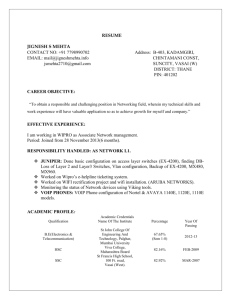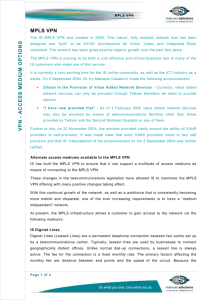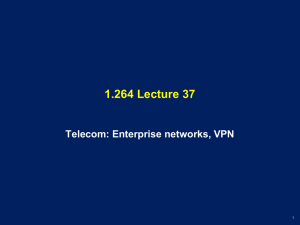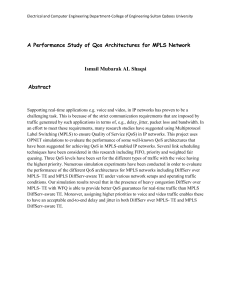I T U NTERNATIONAL
advertisement
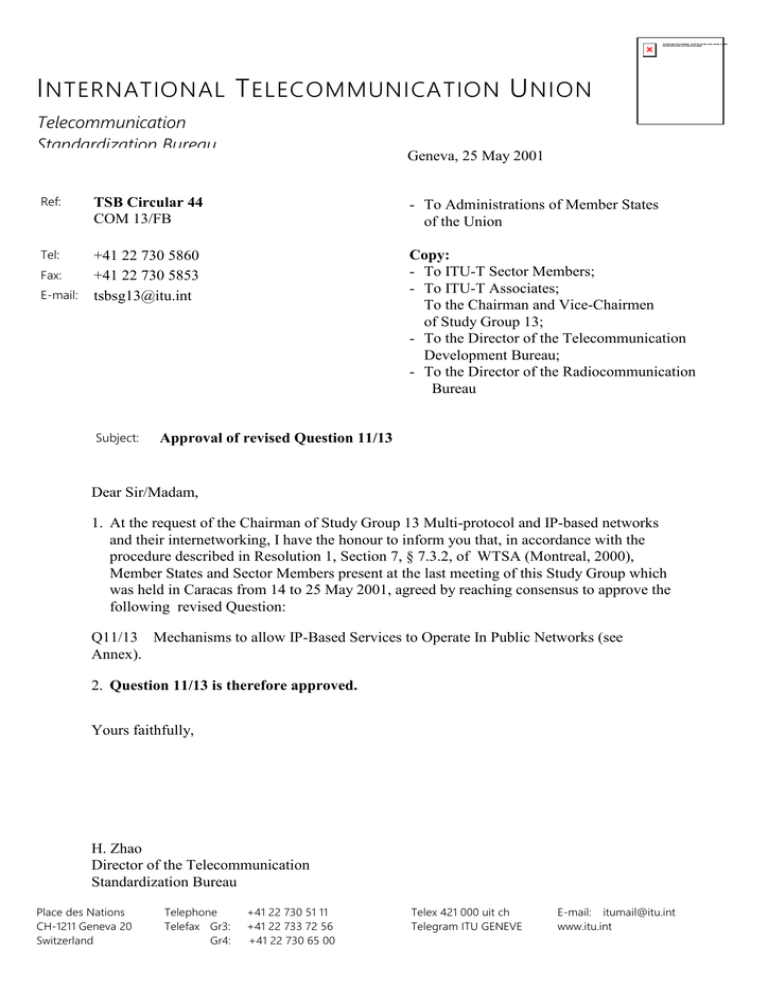
I NTERNATIONAL T ELECOMMUNICATION U NION Telecommunication Standardization Bureau Geneva, 25 May 2001 Ref: TSB Circular 44 COM 13/FB - To Administrations of Member States of the Union Tel: +41 22 730 5860 +41 22 730 5853 tsbsg13@itu.int Copy: - To ITU-T Sector Members; - To ITU-T Associates; To the Chairman and Vice-Chairmen of Study Group 13; - To the Director of the Telecommunication Development Bureau; - To the Director of the Radiocommunication Bureau Fax: E-mail: Subject: Approval of revised Question 11/13 Dear Sir/Madam, 1. At the request of the Chairman of Study Group 13 Multi-protocol and IP-based networks and their internetworking, I have the honour to inform you that, in accordance with the procedure described in Resolution 1, Section 7, § 7.3.2, of WTSA (Montreal, 2000), Member States and Sector Members present at the last meeting of this Study Group which was held in Caracas from 14 to 25 May 2001, agreed by reaching consensus to approve the following revised Question: Q11/13 Mechanisms to allow IP-Based Services to Operate In Public Networks (see Annex). 2. Question 11/13 is therefore approved. Yours faithfully, H. Zhao Director of the Telecommunication Standardization Bureau Place des Nations CH-1211 Geneva 20 Switzerland Telephone Telefax Gr3: Gr4: +41 22 730 51 11 +41 22 733 72 56 +41 22 730 65 00 Telex 421 000 uit ch Telegram ITU GENEVE E-mail: itumail@itu.int www.itu.int -2- Annex (to TSB Circular 44) QUESTION 11/13 Mechanisms to allow IP-Based Services to Operate In Public Networks (Continuation of Question 20/13) Background and justification With the rapid growth of IP networks and services, a demand has been continuously increased to enhance the networking capabilities to transport IP traffic in public networks. In the IETF, MPLS has been proposed as a promising solution, and the basic protocol stacks have been developed to transport IP traffic in private networks. In ITU-T, MPLS has been recommended as a preferred network solution to transport IP traffic in public ATM networks in Recommendation Y.1310. However, to encourage the deployment of MPLS based networks, and to deal with more advanced IP features in a timely manner, there is a crucial need to enhance the functional capabilities of IP/MPLS based networks which have been addressed in ITU-T and IETF. The functional capabilities that should be studied more extensively include the traffic engineering and IP service provisioning capabilities in MPLS based public networks. Moreover, there is a crucial need to address issues related to the carriage of IP traffic, including its specific control, user and management plane components in a homogeneous framework. More importantly, the analysis should take into account: (1) The interaction with complementary transport technologies such as conventional Layer 2 technologies (ATM, FR, PPP, etc) or Layer 1 technologies (SDH, WDM), (2) access platforms including wireless, Xdsl, cable and other access means, (3) seamless VPN services by various types of access means and core IP networks and (4) new services specific requirements such as e-business and web hosting. MPLS should be given priority in the initial phase of the work. With an end-to-end service delivery as a goal, Recommendations are needed to describe and specify ways of developing interoperable implementations in order to accommodate broadband-based IP services. Related studies of these items have partly been initiated and progressed in other standard bodies. However, there is a crucial need for coordination and consolidation to integrate those studies with work in ITU-T. There is a clearly identified need to specify mechanisms to support Virtual Private Networks (VPN) services over MPLS networks and Recommendation Y.1310 does not currently define detailed specifications for this. Furthermore, it is clear that Recommendations must describe and specify ways of developing interoperable implementations in order to allow end-to-end service delivery across a multi-vendor network infrastructure. Inside IETF no specific standards for VPN services support over MPLS have been produced up to now (the PPVPN working group on Provider Provisioned VPNs was formed at the end of January 2001, the MPLS working group previously chose to do not deal with MPLS VPNs). Service Providers have urgent needs to deploy VPN services over telecommunications network infrastructures and they require carrier class and fully interoperable implementations. Furthermore, enhancements are needed to address various emerging and more complex VPN service scenarios which will be crucial for Service Providers. There is then a need for more detailed specifications to meet these needs. ITU-T\ITU-COM\COM13\CIRC\044E.DOC -3- Other crucial IP-based services (to be identified) could be also specified in terms of service requirements based on existing and emerging Service Providers needs and may use MPLS or other architectures such as ATM or Frame Relay. For each of them, mechanisms to support the service should be defined. Items for study Studies should concentrate on the following aspects: 1. Y.1310 has selected MPLS as the preferred architecture for IP transport over ATM. There is a need to investigate whether or not this remain valid if other Layer 2 or Layer 1 technologies are used. (Note: Coordination with Question 10/13 is required). 2. Specification of mechanisms to support QoS-aware IP services in MPLS based networks. 3. In Recommendation Y.1310, only the conceptual framework and the service mapping issues have been addressed to support IP QoS services such as intserv and diffserv. To provide a more useful solution for network and service providers, a specification of a more consolidated non-control mechanisms for transport of IP diffserv (and intserv) over MPLS based networks is required. (Note: Harmonization with Question 4/13 is required). 4. It is noted that MPLS has many advantages in terms of traffic engineering. Therefore, it is helpful to analyze and specify the traffic engineering requirements, and to provide guidelines and support mechanisms for network and service providers in public MPLS network environments. 5. Further investigation and identification of control and label distribution protocols and architectures is required especially as new technologies are developed. 6. Specification of mechanisms to support each identified additional IP-based service over MPLS networks (e.g. IP multicast, Voice over MPLS, Web-hosting, E-business). 7. The specific topic of VPN service support is of high priority. Recommendation Y.1310 includes the definition of IP-VPN, based on the BGP/MPLS VPN approach. However, other approaches are not excluded. Work items are: a) Identification of capabilities to provide VPN services. b) Specification of needed requirements in order to provide carrier class service (scalability, performance). In order that specification makes sense, a quantitative definition of a carrier class VPN service should be provided in terms of scaling projections and performance. c) Specification of (existing and additional) non-control mechanisms to support various VPN service deployment scenarios (main scenarios still to be defined). Examples are: simultaneous access to VPN service and Internet, support of multiple Quality of Service levels, VPNs with Bandwidth Guarantees, perVPN traffic Engineering, VPNs with multi-homing access connectivity. d) Specification of enhancements to provide new and/or more advanced VPN service deployment scenarios (main scenarios have to be defined). Examples are: inter-Provider VPN service, hierarchical VPN service (example: carriers’carrier), VPN service interworking between VPN backbone service over MPLS and IP tunnelling-based VPN user access (dial users). e) Specification of mechanisms to configure and manage VPNs with various accesses methodologies including broadband e.g. FR/ATM, dial-up and mobile/wireless interoperation. ITU-T\ITU-COM\COM13\CIRC\044E.DOC -4- Specific tasks and deadlines IP-VPN over MPLS (Y.1311.1): 2002 IP/MPLS Transport and Control Protocols (Y.131Z): 2002 IP-based service “X” over MPLS (Y.131X.1 (for each identified additional IP-based service over MPLS) Relationships ITU-T Study Groups on signalling (MPLS Control Protocol) and network and service management ITU-R Study Groups on broadcasting and mobile aspects IETF (MPLS, CCAMP, IDR, PPVPN, IPO, and Internet Traffic Engineering WGs) ATM Forum MPLS Forum TM Forum ITU-T\ITU-COM\COM13\CIRC\044E.DOC

